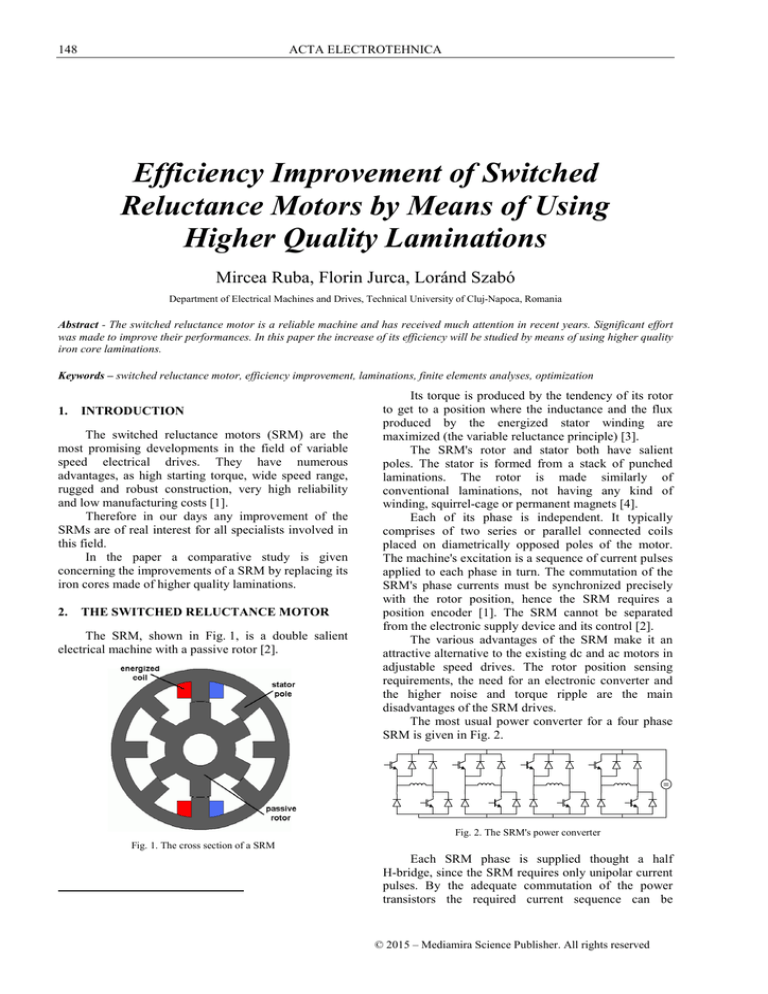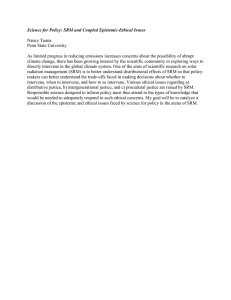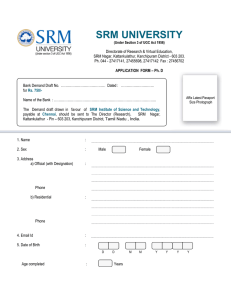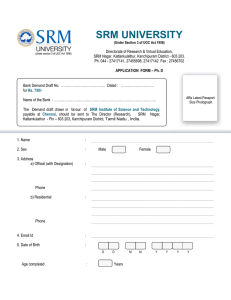
ACTA ELECTROTEHNICA
148
Efficiency Improvement of Switched
Reluctance Motors by Means of Using
Higher Quality Laminations
Mircea Ruba, Florin Jurca, Loránd Szabó
Department of Electrical Machines and Drives, Technical University of Cluj-Napoca, Romania
Abstract - The switched reluctance motor is a reliable machine and has received much attention in recent years. Significant effort
was made to improve their performances. In this paper the increase of its efficiency will be studied by means of using higher quality
iron core laminations.
Keywords – switched reluctance motor, efficiency improvement, laminations, finite elements analyses, optimization
1.
INTRODUCTION
The switched reluctance motors (SRM) are the
most promising developments in the field of variable
speed electrical drives. They have numerous
advantages, as high starting torque, wide speed range,
rugged and robust construction, very high reliability
and low manufacturing costs [1].
Therefore in our days any improvement of the
SRMs are of real interest for all specialists involved in
this field.
In the paper a comparative study is given
concerning the improvements of a SRM by replacing its
iron cores made of higher quality laminations.
2.
THE SWITCHED RELUCTANCE MOTOR
The SRM, shown in Fig. 1, is a double salient
electrical machine with a passive rotor [2].
Its torque is produced by the tendency of its rotor
to get to a position where the inductance and the flux
produced by the energized stator winding are
maximized (the variable reluctance principle) [3].
The SRM's rotor and stator both have salient
poles. The stator is formed from a stack of punched
laminations. The rotor is made similarly of
conventional laminations, not having any kind of
winding, squirrel-cage or permanent magnets [4].
Each of its phase is independent. It typically
comprises of two series or parallel connected coils
placed on diametrically opposed poles of the motor.
The machine's excitation is a sequence of current pulses
applied to each phase in turn. The commutation of the
SRM's phase currents must be synchronized precisely
with the rotor position, hence the SRM requires a
position encoder [1]. The SRM cannot be separated
from the electronic supply device and its control [2].
The various advantages of the SRM make it an
attractive alternative to the existing dc and ac motors in
adjustable speed drives. The rotor position sensing
requirements, the need for an electronic converter and
the higher noise and torque ripple are the main
disadvantages of the SRM drives.
The most usual power converter for a four phase
SRM is given in Fig. 2.
Fig. 2. The SRM's power converter
Fig. 1. The cross section of a SRM
Each SRM phase is supplied thought a half
H-bridge, since the SRM requires only unipolar current
pulses. By the adequate commutation of the power
transistors the required current sequence can be
© 2015 – Mediamira Science Publisher. All rights reserved
149
Volume 56, Number 4, 2015
assured. The diodes are for guiding the reverse currents.
The bridges of the phases are connected in parallel with
a dc line.
The most common control system of the SRMs is
given in Fig. 3.
ωref
+
e
Velocity i*
Controller
-
Hysteresis
Power
Current Gate signals
Converter
Controller
SRM
ωr
☼
Current feedback
d/dt
Position feedback
As it can be observed, the specific losses of the
M330-50A electrical steel are round 20% less than
those of the M400-50A type.
The designed SRMs were analyzed by means of
advanced finite elements method (FEM) based
numerical field analysis. The Flux 2D program package
of Cedrat was applied [21].
In Fig. 4 the solid model and the automatically
generated solution mesh are given for the basic
structure of the designed SRM.
θr
Fig. 3. The SRM's control system
Deriving upon time the output of the position
encoder the angular speed can be obtained. This is
compared to the imposed speed. The error between
them is the input of the speed controller; witch will
impose the current waveforms for the hysteresis
controllers of each phase. The commutation between
the phases is performed at a well-defined angular rotor
position in order to maximize the developed torque.
The hysteresis controllers are delivering gate signals to
the power transistors of the converter [5].
In recent years much research has been done all
around the world in an effort to improve the SRM's
performance and efficiency, to make them more
competitive for several applications.
Novel modular constructions were proposed to
increase the fault tolerance of the machine [6], [7], [8],
[9]. Advanced control strategies were developed to
decrease the torque ripples of the SRMs [10], [11],
[12]. Significant effort has been also made also for the
vibration and noise reduction of these machines [13],
[14], [15]. The SRMs can be improved also by
manufacturing them from high quality soft magnetic
materials [16], [17], [18].
3.
a) the built up solid model
DEVELOPMENT OF AN OPTIMIZED SRM
The target of the research was to develop an
improved 8/6 poles SRM having 3 kW rated power and
1500 r/min rated speed.
A specific design algorithm was applied for the
basic sizing of the machine [19].
The iron core of the SRM was considered to be
manufactured of non-oriented fully processed electrical
steel. Two types of laminations were taken into account
M400-50A and M330-50A, both of 0.5 mm thick. Their
specific losses measured according to the IEC 60404-2
standard are given in Table 1 [20].
Table 1 – Specific losses of the electrical steels
Electrical steel
Maximum specific total losses [W/kg] @
1.5 T
1T
M330-50A
3.3
1.35
M400-50A
4
1.75
b) the generated mesh
Fig. 4. The SRM model in Flux 2D
In order to obtain the best solution a simple, but
yet efficient optimization method was applied. The
optimization target was to maximize the efficiency of
the SRMs. During the iterative optimization the main
dimensions of the machine were varied. Totally 81
variants were taken into account for each case. The
main characteristics of each variant taken into study
were saved and finally compared.
ACTA ELECTROTEHNICA
150
M330-50A
M400-50A
21
Tmean [N⋅m]
Tmean [N⋅m]
21
20
19
20
40
60
80
60
40
20
0
20
40
60
Pmech [kW]
Pmech [kW]
3.1
3
0
20
40
60
60
80
0
20
40
60
80
0
20
40
60
80
0
20
40
60
80
0
20
60
40
Variant number
80
40
20
3.2
3.1
3
250
p Fe [W]
p Fe [W]
40
60
80
250
200
0
20
40
60
200
150
80
0.92
0.92
Efficiency
Efficiency
20
3.3
3.2
0.91
0.9
0.89
0
80
80
3.3
150
19
80
Tripple [%]
Tripple [%]
0
20
0
20
40
60
Variant number
80
0.91
0.9
0.89
Fig. 5. The main results of the optimization
In Fig. 5 the mean torque, the torque ripple, the
iron losses and the efficiency for each variant taken into
study during the optimization are plotted. After a
carefully study of the plots it was concluded that the
best variant (having the highest efficiency) for the SRM
built up of the M400-50A type lamination is that having
number 62 and for the other SRM variant no. 73. The
efficiencies of these variants are very similar, 0.918 and
0.919, respectively.
The optimization procedure also increased the
mean torque of the two SRMs from the initial rated
value equal to 19.1 N·m to 19.37 N·m in the case of the
SRM having M400-50A type laminations and to
20.8 N·m in that having its iron core made of
M400-50A type electric steel. These mean an increase
by 1.41% and 8.9%, respectively. As it can be seen the
improvement in the case of the SRM having higher
quality iron core is more significant.
The best found SRM was supposed to a final
electromagnetic checkout. The flux lines and the color
map of the flux density in the SRM for the position of
the rotor from the beginning of the conduction period
are given in Fig. 6 and 7.
Fig. 6. The flux lines of the optimized SRM
Volume 56, Number 4, 2015
7.
8.
9.
10.
11.
Fig. 7. The color map of the flux densities in the optimized SRM
As it can be seen, the obtained results are in
accordance with the theoretical expectations.
4.
12.
CONCLUSIONS
13.
In the paper it was proved, that the performances
of a common 8/6 poles SRM can be enhanced also by
simple approaches. Its overall performances were
improved by manufacturing its iron core of higher
quality non oriented fully processed electrical steel, and
its efficiency was maximized by means of a simple
FEM-based optimization process.
14.
15.
ACKNOWLEDGMENT
This paper was supported by the Post-Doctoral
Programme POSDRU / 159 / 1.5 / S / 137516, project
co-funded from European Social Fund through the
Human Resources Sectorial Operational Program
2007-2013.
It was also supported by the ResearchDevelopment-Innovation Internal Projects of the
Technical University of Cluj-Napoca (strategic research
topics for young teams: "Design, analysis and control of
permanent magnet synchronous machines as starteralternator-booster unit for hybrid electric vehicles").
REFERENCES
1.
2.
3.
4.
5.
6.
T.J.E. Miller, Electronic Control of Switched Reluctance
Machines. Oxford (U.K.): Newnes, 2001.
G. Henneberger, I.A. Viorel, Variable Reluctance Electrical
Machines. Aachen (Germany): Shaker Verlag, 2001.
K.Á. Bíró, I.A. Viorel, L. Szabó, G. Henneberger, Special
Electrical Machines (in Romanian). Cluj (Romania):
Mediamira, 2005.
R. Krishnan, Switched Reluctance Motor Drives: Modeling,
Simulation, Analysis, Design, and Applications. Boca Raton
(USA): CRC, 2001.
L. Szabó, M. Ruba, D. Fodorean, "Study on a simplified
converter topology for fault tolerant motor drives," in
Proceedings of the 11th International Conference on
Optimization of Electrical and Electronic Equipment
(OPTIM '2008), Braşov (Romania), 2008, pp. 197-202.
Y. Yoshimaru, T. Higuchi, Y. Yokoi, T. Abe, "On the
improvement performance of a dual rotor segment type SRM,"
16.
17.
18.
19.
20.
21.
151
in Proceedings of the 2013 IEEE 10th International Conference
on Power Electronics and Drive Systems (PEDS '2013),
Kitakyushu (Japan), 2013, pp. 1045-1048.
L. Szabó, M. Ruba, "Segmental stator switched reluctance
machine for safety-critical applications," IEEE Transactions on
Industry Applications, vol. 48, no. 6, pp. 2223-2229, 2012.
D. Yamaguchi, T. Higuchi, T. Abe, Y. Yokoi, "A characteristic
experiment of 4-phase segment type switched reluctance
motor," in Proceedings of the 15th International Conference on
Electrical Machines and Systems (ICEMS '2012), Sapporo
(Japan), 2012.
M. Ruba, I.A. Viorel, L. Szabó, "Modular stator switched
reluctance motor for fault tolerant drive systems," IET Electric
Power Applications, vol. 7, no. 3, pp. 159-169, 2013.
M.J. Navardi, B. Babaghorbani, A. Ketabi, "Efficiency
improvement and torque ripple minimization of switched
reluctance motor using FEM and seeker optimization
algorithm," Energy Conversion and Management, vol. 78, no. 2,
pp. 237-244, 2014.
L. Szabó, M. Ruba, D. Fodorean, P. Rafajdus, P. Dúbravka,
"Torque smoothing of a fault tolerant segmental stator switched
reluctance motor," COMMUNICATIONS - Scientific Letters of
the University of Žilina (Slovakia), vol. 1a, pp. 95-101, 2015.
Y. Sozer, I. Husain, D.A. Torrey, "Advanced control techniques
for switched reluctance machine drives in emerging
applications," in Proceedings of the 2013 IEEE Energy
Conversion Congress and Exposition (ECCE '2013), Denver
(USA), 2013, pp. 3776-3783.
J. Li, X. Song, Y. Cho, "Comparison of 12/8 and 6/4 switched
reluctance motor: noise and vibration aspects," IEEE
Transactions on Magnetics, vol. 44, no. 11, pp. 4131-4134,
2008.
Z. Zhu, X. Liu, Z. Pan, "Analytical model for predicting
maximum reduction levels of vibration and noise in switched
reluctance machine by active vibration cancellation," IEEE
Transactions on Energy Conversion, vol. 26, no. 1, pp. 36-45,
2011.
K. Edamura, I. Miki, "Design of stator and rotor for noise
reduction of SRM," in Proceedings of the 17th International
Conference
on
Electrical
Machines
and
Systems
(ICEMS '2014), Hangzhou (China), 2014, pp. 1871-1874.
L. Szabó, I.A. Viorel, V. Iancu, D.C. Popa, "Soft magnetic
composites used in transverse flux machines," Oradea
University Annals, Electrotechnical Fascicle, pp. 134-141,
2004.
T. Rusu, A.-C. Pop, L. Szabó, C. Marţiş, "Study of winding
arrangement and material quality effects on the core losses in
high speed switched reluctance machines," in Proceedings of
the 13th International Conference on Engineering of Modern
Electric Systems (ICEMES '2015), Oradea (Romania), 2015,
pp. 243-246.
F. Chauvicourt, S. Orlando, W. Desmet, J. Gyselinck, H. Van
der Auweraer, C. Faria, "Experimental and numerical validation
of laminated structure dynamics from a switched reluctance
machine stator," in Proceedings of the 2015 International
Conference
on
Structural
Engineering
Dynamics
(ICEDyn '2015), Lagos (Portugal), 2015.
M. Ruba, L. Szabó, D. Fodorean, "Design and analysis of low
voltage high current SRM for small automotive applications," in
Proceedings of the 2012 International Symposium on Power
Electronics, Electrical Drives, Automation and Motion
(SPEEDAM '2012), Sorrento (Italy), 2012, pp. 341-346.
COGENT - Electrical Steel, Non Oriented, Fully Processed.
Surahammar (Sweden): Surahammars Bruks AB, 2013.
"Package for Electromagnetic and Thermal Analysis Using
Finite Elements – Flux 2D User's Guide," ed. Meylan (France):
Cedrat, 2005.
Mircea Ruba
Department of Electrical Machines and Drives
Technical University of Cluj-Napoca
28, Memorandumului st., Cluj-Napoca, Romania
mircea.ruba@mae.utcluj.ro



